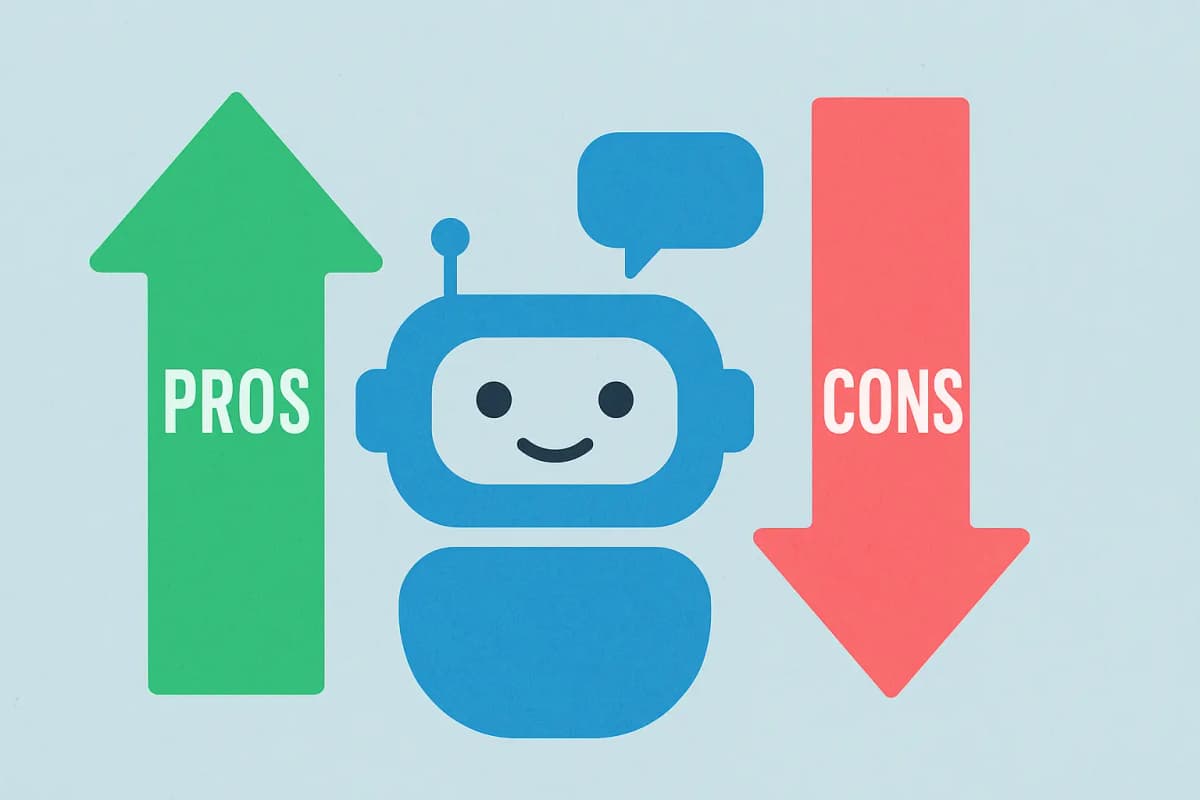19 Chatbase Alternatives to Consider.
Here are 19 AI Chatbot apps you can consider when looking for Chatbase alternatives
Darius Talemwa
Author
Chatbase isn’t the only game in town.
If you’re looking for a chatbot that can live on your website, answer customer questions, and free up your support team, you have plenty of options.
I spent ten focused hours testing or digging deep into the documentation, demos, and real‑world use cases of every provider on this list. I poked through pricing pages, built sample bots, and chatted with support reps so you don’t have to.
In this guide I’ll lay out two broad categories:
Proprietary, hosted alternatives you can deploy in minutes.
Open‑source, self‑hosted platforms for teams that want maximum control.
But first, here is the TLDR.
The 19 Chatbot Alternatives to consider are;
SiteChatify – Most Affordable AI chatbot with lifetime deals.
SiteGPT – Website-focused chatbot with multi-language support and scalable plans for large sites.
Botsonic – No-code tool for scanning sites and docs, with agentic actions and broad integrations like WhatsApp and Slack.
Chatfuel – Popular no-code platform for social media bots, offering flows, broadcasts, and integrations.
MyAsk AI – AI support agent for websites and email, with auto-responses, Chrome copilot, and analytics.
Chatwith Tools – No-code builder for custom GPT chatbots trained on website and file content, with 6,000+ integrations.
ManyChat – Multichannel automation for Messenger, Instagram, WhatsApp, with flows, growth tools, and unified inbox.
Chatbot.com – All-in-one chatbot builder with AI Assist, live chat handover, and rich analytics.
Tidio – Customer support platform combining live chat, Lyro AI chatbot, and e-commerce integrations.
Fin (Intercom) – Pay-per-resolution AI agent for multi-channel support across chat, email, and social.
Botpress – Top open-source platform for building AI chatbots with full control, integrations, and LLM orchestration.
Microsoft Bot Framework – Open-source SDK for multi-channel bots, with powerful Azure integrations and free hosting options.
LLaMA – Meta’s large language models, source-available for custom AI projects and high-performance chat.
OpenDialog – No-code open-source platform for enterprise AI agents with RAG, analytics, and LLM guardrails.
DeepPavlov – Open-source NLP framework for modular chatbot pipelines and multi-skill virtual assistants.
Claudia Bot Builder – Lightweight Node.js tool for multi-platform bots, simplifying AWS Lambda deployments.
BotMan – PHP library for multi-channel bots with expressive syntax and flexible integrations.
Tock – Open-source conversational AI toolkit with modular NLU, visual flow builder, and multi-channel support.
Bottender – JavaScript framework for declarative chatbot building across messaging platforms.
That's the summarised version for those who have better things to do than to read a ~ 10k word blog post on chatbots.
For those sticking around for the details, you’re in for a deep dive. For each tool you’ll see that I have added the key features, pros and cons, pricing, and a quick head‑to‑head with Chatbase.
First up, let's dive into proprietary Chatbase alternatives. Tools you can start using today without spinning up your own server.
Proprietary Chatbase Alternatives
When I talk about proprietary chat platforms, I’m talking about hosted Software as a Service (SaaS) tools that make it incredibly easy to build and launch a chatbot without touching a single line of code or worrying about servers.
They take care of the infrastructure, updates, and support, so you can focus on getting results fast.
Sure, they’re usually less customizable than open-source options, but if you’re after something simple, user-friendly, and reliable right out of the box, these platforms are hard to beat.
1. SiteChatify
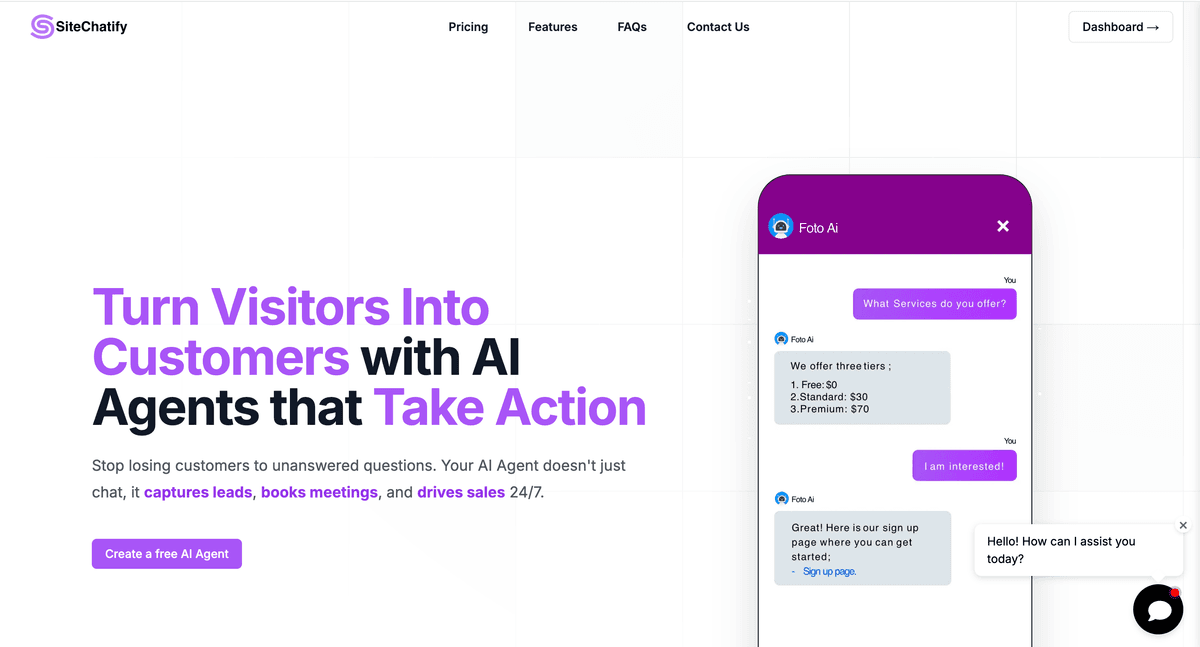
Ok clearly this is our product, but hear me out.
SiteChatify lets you create AI-powered chatbots that answer questions using your website content, uploaded documents, and custom knowledge base.
I set up a demo bot in minutes by adding website URLs and uploading a PDF - no coding required, just paste your links and let the AI do the work.
Key Features:
Crawls unlimited website links and supports file uploads (PDF, DOC, DOCX, TXT) up to 10MB per file.
AI agent actions including lead capture forms, Calendly integration, custom buttons, and Zendesk ticket creation.
Integrations with Slack, Zendesk, HubSpot, and API access for custom workflows.
Pricing (USD):
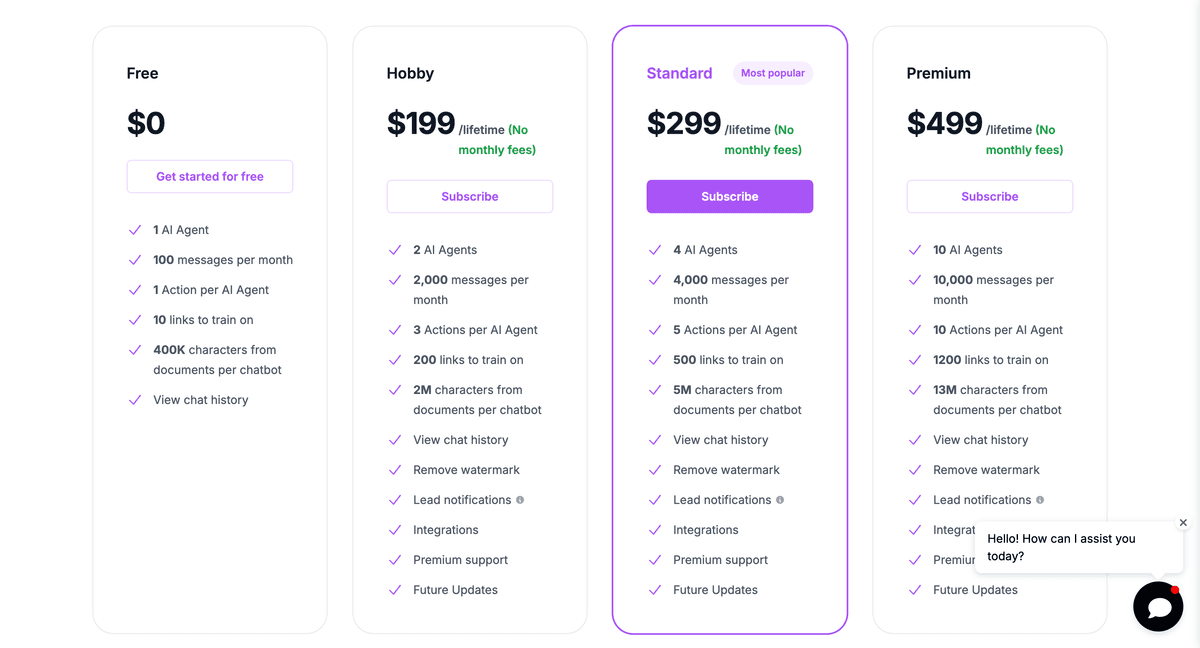
Free – $0: 1 AI agent, 100 messages, 10 links, 400K characters.
Hobby – $25/month or $199 lifetime: 2 agents, 2K messages, 200 links, 2M characters.
Standard – $40/month or $299 lifetime: 4 agents, 4K messages, 500 links, 5M characters.
Premium – $70/month or $499 lifetime: 10 agents, 10K messages, 1,200 links, 13M characters.
SiteChatify Pros and Cons
Pros
- Lifetime deal option - pay once, own forever with no monthly fees.
- Generous character limits for uploaded documents (up to 13M characters per chatbot on Premium).
- Real-time chat history and lead notifications via email, Slack and Hub spot.
- Comprehensive customization including colors, fonts, popup messages, and watermark removal.
Cons
- 10MB file upload limit may restrict large document processing.
- Integrations and advanced actions limited to paid plans only.
- No self-hosted option (cloud-only SaaS platform).
SiteChatify vs Chatbase
Feature
SiteChatify
Chatbase
SiteChatify
Chatbase
Pricing
Pricing
Data Limits
Data Limits
Integrations
Integrations
2. SiteGPT
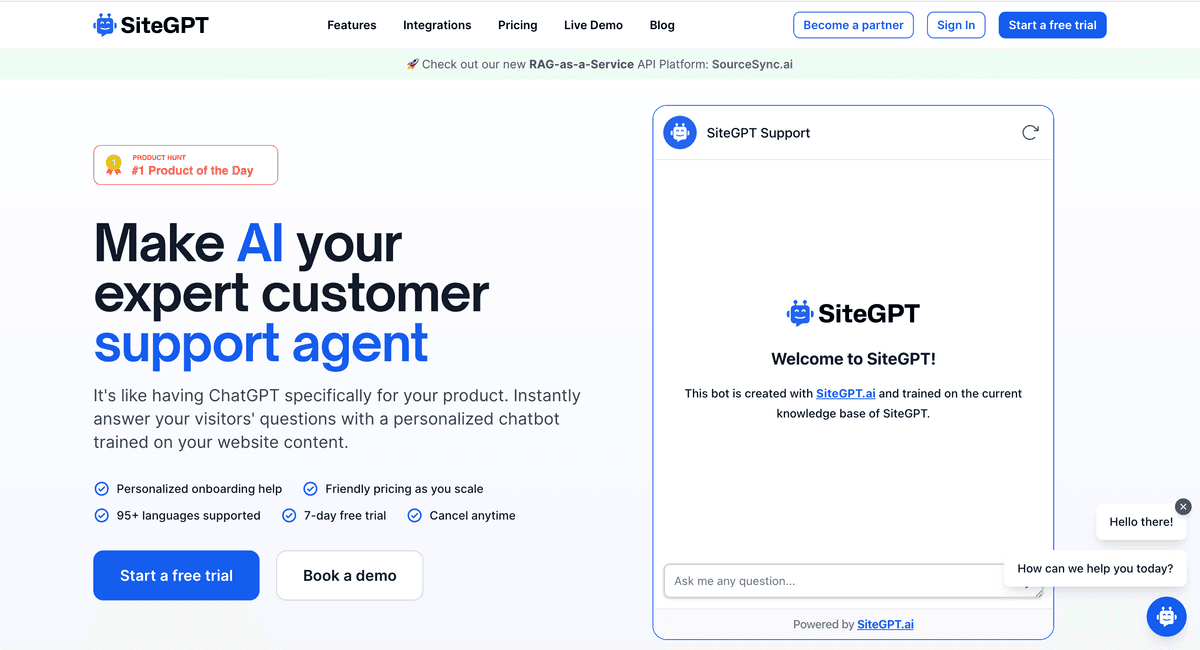
SiteGPT lets you build a chatbot that answers questions using the content already on your website (plus PDFs, docs, and more). I trained a demo bot in under 10 minutes by pasting a URL - no coding required.
Key Features:
Crawls up to 10,000 pages (Scale plan) and supports file uploads (CSV, PDF, DOCX, etc.).
Multi‑language support (95+ languages) and brand‑tone controls.
Embeddable widget, standalone chat page, and integrations with Zendesk, Intercom, Slack, and Zapier.
API + webhook access for custom workflows.
Pricing (USD, monthly):
Starter – $39/month: 1 bot, 4 k messages, 200 pages.
Growth – $79/month: 2 bots, 10 k messages, 2,000 pages, API.
Scale – $259/month: 5 bots, 40 k messages, 10,000 pages, webhooks.
Enterprise – Custom; up to 1,000 bots and priority support.
SiteGPT Pros and Cons
Pros
- Fast, no‑code setup; good default answers out of the box.
- Affordable entry tier and 7‑day free trial.
- Granular retrain button lets you update answers anytime.
Cons
- 10 MB per file cap can be limiting for large manuals.
- Message caps (4 k–40 k/month) mean costs rise with heavy traffic.
- No on‑prem/self‑hosted option (SaaS only).
SiteGPT vs Chatbase
Feature
SiteGPT
Chatbase
SiteGPT
Chatbase
Price
Price
Integrations
Integrations
Brand Voice Control
Brand Voice Control
File (pdf, txt,docx etc) Limits
File (pdf, txt,docx etc) Limits
3. Botsonic
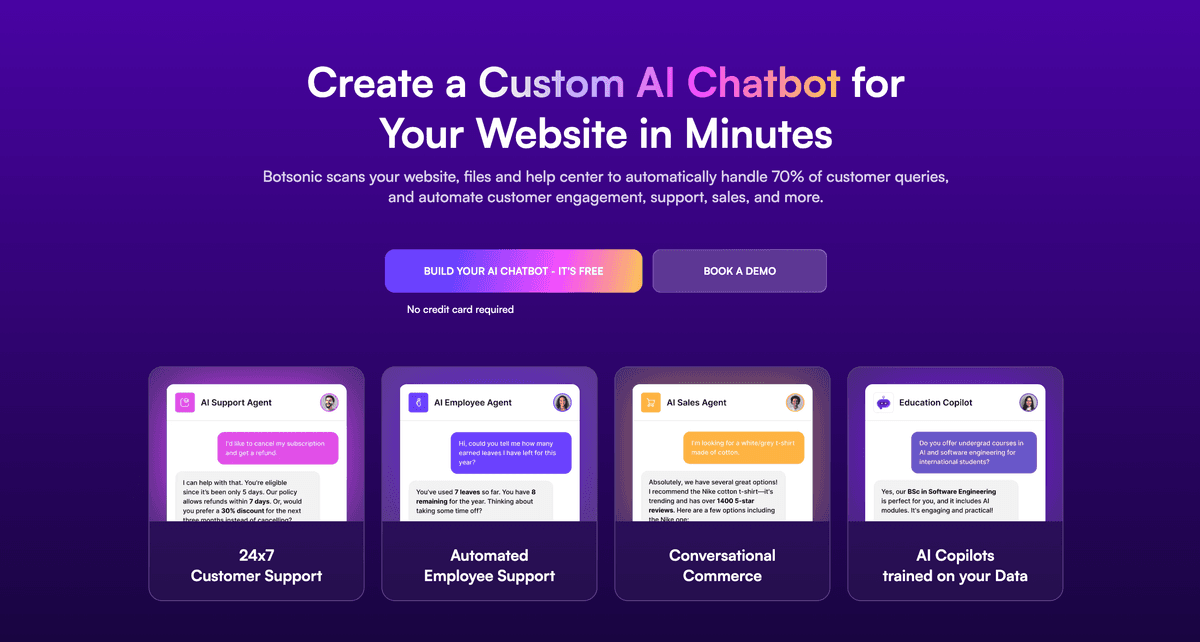
Botsonic automatically scans your website, help center, and uploaded files to handle up to 70% of customer queries, drive engagement, and automate tasks using AI-powered agentic workflows. It supports GPT-4o mini and robust integrations across web and messaging channels.
Key Features:
AI Agentic Actions: Automate tasks like fetching order data, scheduling, and content updates with 3 - 10 actions depending on plan.
Website & File Scanning: Upload sitemaps (up to 5,000 URLs) and files (10 M - 100 M characters) for comprehensive knowledge ingestion.
Multi-channel Integrations: WhatsApp, Facebook Messenger, Telegram, Zapier, WordPress, Google Tag Manager, Google Drive; plus Slack, Google Chat, Calendly, Notion on higher tiers.
Team & Collaboration: Starter includes 1 seat; Professional 2; Advanced 5, with add‑ons for more seats.
Pricing (USD, monthly, billed annually/monthly):
Starter - $16 / $19: 1 chatbot, 1 000 msgs, 3 Agentic Actions, 10 M characters.
Professional - $41 / $49: 2 bots, 3 000 msgs, 5 Agentic Actions, 50 M characters.
Advanced - $249 / $299: 5 bots, 12 000 msgs, 10 Agentic Actions, 100 M characters.
Enterprise - Custom; priority support, custom limits.
Add‑ons: remove branding ($49/mo), extra messages (2 000 msgs for $25/mo), extra seats ($99/bot), extra team members ($25/member), extra characters ($10/20 M).
Botsonic Pros and Cons
Pros
- 7‑day free trial and clear, predictable tiered pricing.
- Powerful agentic workflows enable autonomous self‑service.
- Deep integrations with e‑commerce and support platforms.
- Generous upload and character allowances for knowledge bases.
Cons
- Message limits (1 k - 12 k/month) may require add‑ons at scale.
- Additional seats and features cost extra via add‑ons.
- Software as a Service (Saas) only - no self‑hosting option.
Botsonic vs Chatbase
Feature
Botsonic
Chatbase
Botsonic
Chatbase
Pricing
Pricing
AI Approach
AI Approach
Integrations
Integrations
Customization
Customization
4. Chatfuel
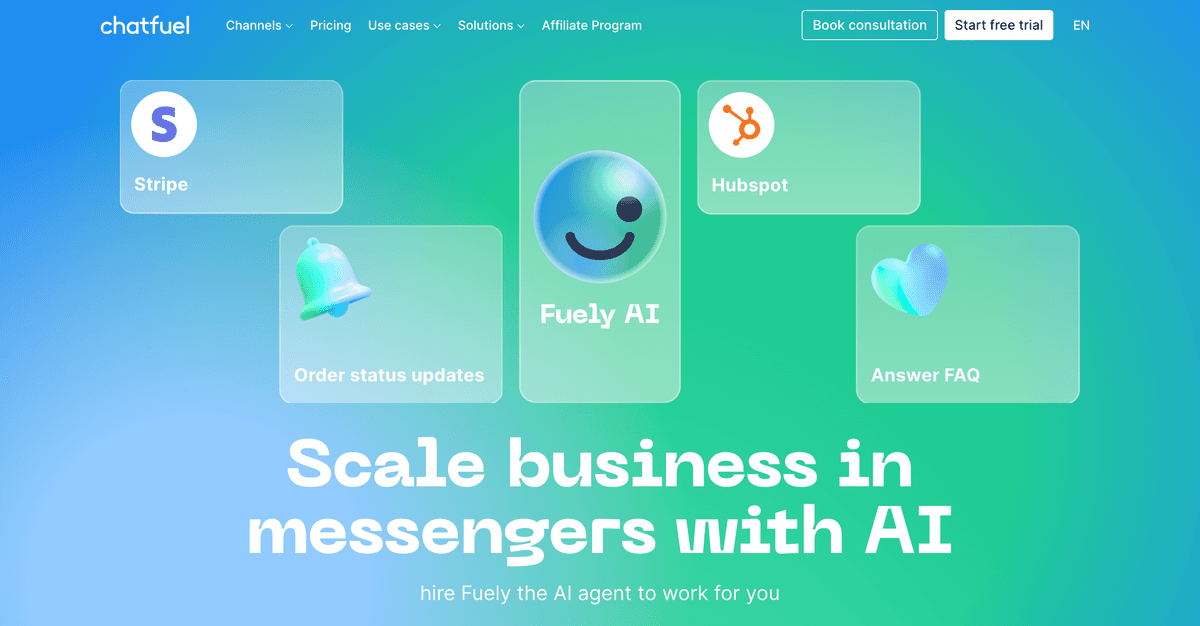
Chatfuel is a popular no-code platform that lets you build AI chatbots for Facebook Messenger, Instagram, WhatsApp, and even your website via an embeddable chat widget.
It includes an AI assistant called Fuely AI to answer visitor questions and route into human chat seamlessly.
Key Features:
Drag-and-drop Flow Builder with conditional logic, user attributes, segmentation, A/B testing, and extensive templates.
Fuely AI supports smart responses, live chat handover, and appointment booking
Multichannel support: Facebook, Instagram, WhatsApp and website; Telegram and others via plugins.
Broadcasts and drip Sequences across channels with segmentation and analytics.
Integrations with Google Sheets, Shopify, Zapier, Stripe and custom webhooks.
Support for rich media: images, buttons, quick replies, files.
Pricing (USD, monthly):
Free Trial: 7‑day free trial (no ongoing free plan).
Business (FB/IG): From $23.99/month for 1,000 conversations (extras $0.02 each).
WhatsApp: From $34/month for 1,000 conversations (extras $0.04 + Meta fees).
Enterprise: Custom plans start at ~$300/month with priority support and dedicated bot‑builder.
Chatfuel Pros and Cons
Pros
- No-code setup and intuitive UI. Great for non-technical teams.
- Cost-effective AI features, particularly with Fuely AI built into base plans.
- Supports live-human handover and unified Inbox across channels
- Extensive template library and large user community.
Cons
- 7-day free trial, after which you’ll need to upgrade to a paid plan to continue handling conversations.
- Pricing quickly increases based on conversation volume. $23.99/month for 1,000 Facebook/Instagram conversations or $34.49 for WhatsApp.
- Less flexible for website Q&A than Chatbase; best suited to scripted, flow-based dialogues.
Chatfuel vs Chatbase
Feature
Chatfuel
Chatbase
Chatfuel
Chatbase
Primary Use Case
Primary Use Case
Pricing Model
Pricing Model
Chat Experience
Chat Experience
Customization & Integrations
Customization & Integrations
5. MyAsk AI
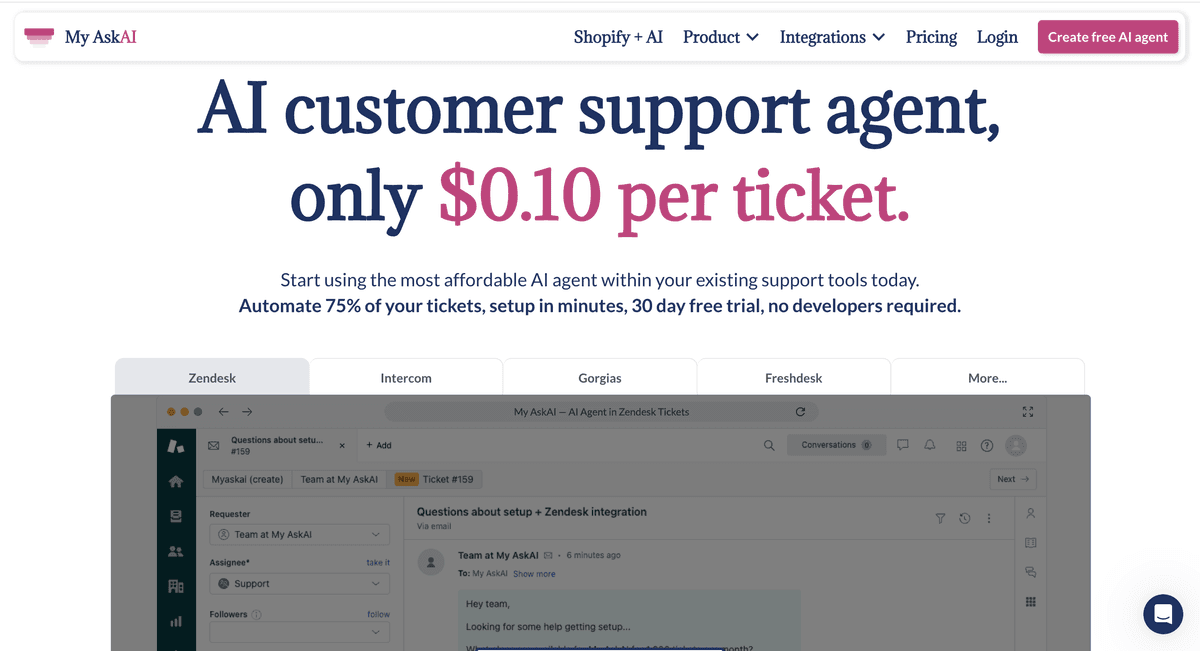
MyAsk AI lets you spin up a dedicated AI support agent in under 5 minutes, training it on your website, help docs, and uploaded files. It seamlessly embeds on sites or integrates with tools like Zendesk, Intercom, Slack, and email.
Key Features:
30-day free trial (full access, no credit card required), then $0.10 per ticket/conversation
Content ingestion: add & auto-sync unlimited websites and documents (PDFs, presentations, etc.)
AI email assistant: fully auto-responds to customer emails 24/7 using your company knowledge
Chrome Extension AI Copilot: get AI support directly in your browser or inside live-chat tools
Human handover: intelligently route complex queries back to your existing live-chat or email channels
Custom branding & private mode: white-label your agent and enable private (internal-only) knowledge bases
Analytics & insights: dashboard with basic & advanced analytics, Customer Satisfaction Score (CSAT) capture, lead capture, and a Knowledge Improvement Studio
Multilingual support & team seats: fully multilingual (95+ languages) and unlimited team seats on Pro/Enterprise plans.
Pricing (USD, monthly):
Essentials – $89: 200 conv/mo, 30‑day trial, content ingestion, email AI, handover.
Pro – $149: 1,000 conv/mo, advanced insights, unlimited seats, priority support.
Enterprise – Custom: unlimited conv, custom SLAs, white‑label, HIPAA, audit logs.
MyAskAI Pros and Cons
Pros
- Proven 75–84% deflection rates, freeing agents for high‑value issues.
- Deep native connectors to Intercom, Zendesk, Freshdesk, Gorgias, and more.
- Transparent $0.10/conversation pricing beyond plan limits caps unpredictable overages.
Cons
- Base plans limit 200–1,000 conversations per month before per‑ticket charges apply.
- No perpetual free tier; only a time‑bound trial.
- Advanced features (API access, Teams, Zapier) require Pro/Enterprise tiers.
MyAsk AI vs Chatbase
Feature
MyAskAI
Chatbase
MyAskAI
Chatbase
Pricing Model
Pricing Model
Primary Use Case
Primary Use Case
Integrations
Integrations
6. Chatwith Tools
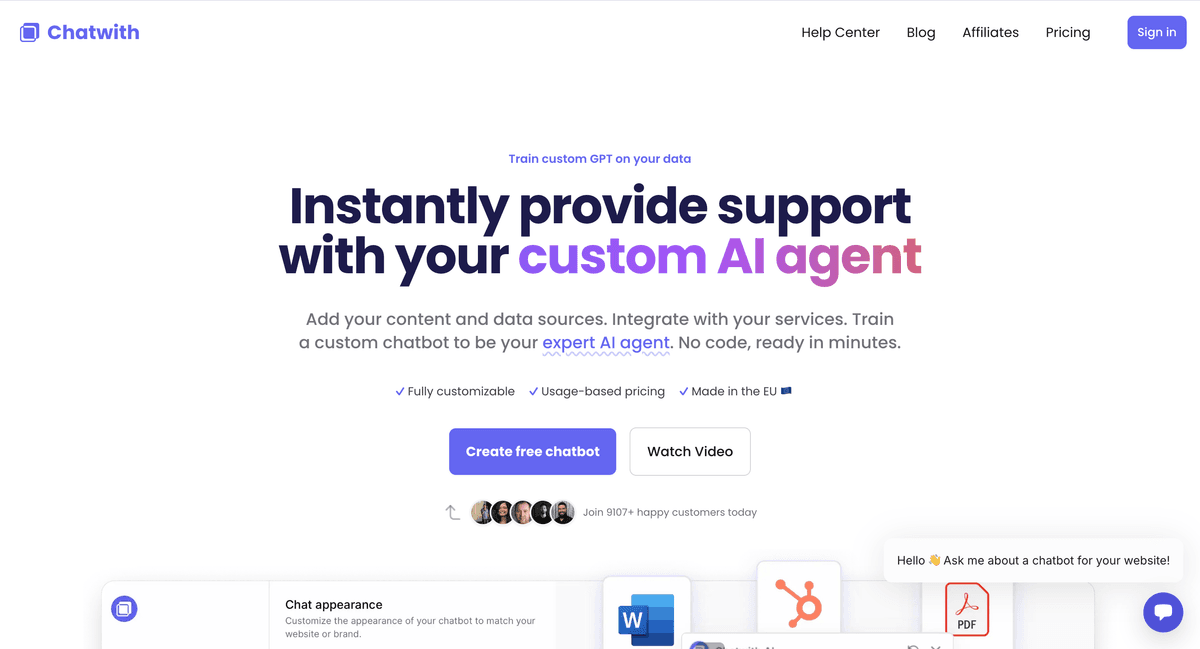
Chatwith Tools lets you spin up a custom ChatGPT chatbot trained on your website, sitemaps, and docs in minutes - no code required. It powers a live chat widget, supports multichannel embeds, and integrates with 6,000+ pre-built apps.
Key Features:
Content Ingestion: Crawl websites, import sitemaps, and upload files (PDF, PPT, DOCX) for daily/weekly auto-training.
No-Code Editor: Customize chat flows, guardrails (prevent off-topic queries), lead capture forms, and team management without dev help.
Integrations: Plug into 6,000+ apps via native connectors and Zapier. Embed on WordPress, Shopify, Webflow, Slack, Microsoft Teams, and more.
Security & Compliance: GDPR-ready (EU hosting), BYOK encryption, and domain authorization.
Analytics & Notifications: Real-time usage alerts, conversation export, and performance dashboards.
Pricing (USD, monthly):
Hobby – $19: 1 bot, 1,000 msgs.
Standard – $99: 3 bot, 10,000 msgs.
Business – $399: 5 bots, 40,000 msgs.
All plans come with a 14 day free trial.
Chatwith.tools Pros and Cons
Pros
- Usage-based message credits roll over month-to-month so you only pay for what you use.
- 14-day free trial on all plans; cancel anytime.
- Enterprise-grade guardrails for safe, on-brand conversations.
- Rich integration ecosystem eases deployment across platforms.
Cons
- No Permanent Free Tier: After the 14-day trial, you must move to a paid plan.
- Usage-based costs can spike unpredictably during traffic surges.
Chatwith.tools vs Chatbase
Feature
Chatwith.tools
Chatbase
Chatwith.tools
Chatbase
Pricing
Pricing
Integrations
Integrations
7. ManyChat
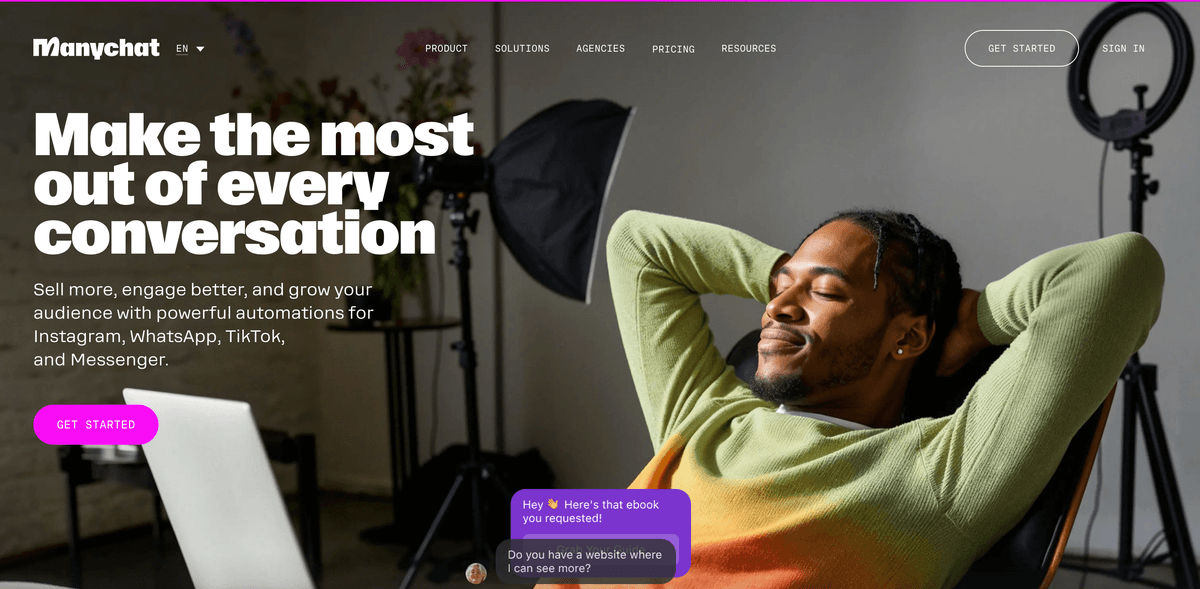
ManyChat started as a Facebook Messenger bot builder and has grown into a multi‑channel automation platform for Instagram, WhatsApp, TikTok, SMS, and email. You design conversations in a drag‑and‑drop Flow Builder, then embed a chat widget on your site or trigger DMs from social posts.
Key Features:
Visual Flow Builder with conditional logic, A/B testing, and a template marketplace.
Manychat AI add‑on to generate replies and summarize chat threads.
Unified Inbox that lets agents jump into live chats across all channels from one screen.
Growth Tools for on‑site pop‑ups, slide‑ins, and an embeddable chat bubble.
Native integrations with Shopify, Stripe, Zapier, and Make.
Pricing (USD, monthly):
Free – $0: up to 1,000 contacts, basic Growth Tools.
Pro – $15+: starts at $15 for ≤500 contacts and scales with list size (pricing slider on the ManyChat pricing page).
Inbox – $99: Includes 3 Live Chat seats; extra seats cost $39 each.
Custom – Quote‑based for large, multi‑brand operations.
ManyChat Pros and Cons
Pros
- Free tier supports up to 1,000 contacts. Great for trying before you buy.
- Huge ecosystem of templates, tutorials, and a 100 k‑strong community.
- Visual builder makes complex automations approachable for non‑dev teams.
Cons
- Pricing scales by contacts, so costs climb fast once you pass a few thousand subscribers.
- Website widget is lead‑gen focused; it can’t auto‑answer long‑tail knowledge‑base queries the way Chatbase does.
- No on‑premises/self‑hosted option.
ManyChat vs Chatbase
Feature
ManyChat
Chatbase
ManyChat
Chatbase
Primary Use Case
Primary Use Case
Pricing Model
Pricing Model
AI Depth
AI Depth
8. ChatBot.com
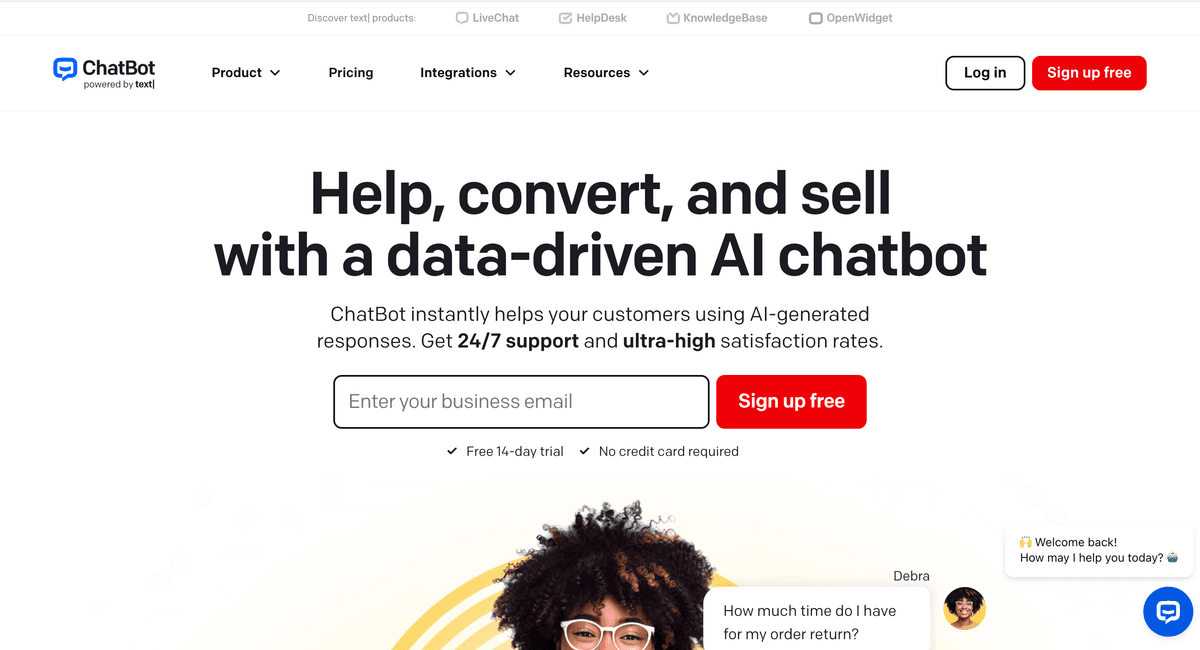
ChatBot.com offers an all‑in‑one AI chatbot platform with generative AI Assist, live chat handover to LiveChat/HelpDesk, and a robust Visual Builder - no developers needed to automate support or sales workflows (sign up free, 14‑day trial)
Key Features:
Visual Builder & Templates: Drag‑and‑drop editor with 19+ templates, subflows, A/B testing, and rich media (buttons, images)
AI Assist: Generative responses trained on your website, help center, and docs; automatic retraining and fine‑tuning options
Live Chat & Ticketing Integration: Seamless handover to LiveChat or HelpDesk agents; create tickets or transfer chats on demand
Advanced Workflows & Data Collection: Dynamic responses, Shopify flows, data capture forms, custom attributes, segments, and moments to personalize chat experiences
Analytics & Reporting: Real‑time dashboards for chat volume, resolution rates, CSAT, training history, and exportable conversation logs.
Integrations: Native connectors for LiveChat, HelpDesk, Facebook Messenger, Shopify, Slack, WordPress, Zapier, and custom APIs.
Pricing (USD, monthly):
Starter – $52 (billed annually; $65/mo month‑to‑month): 1 active chatbot, 12,000 chats/yr, 7-day training history.
Team – $142 (billed annually; $169/mo month‑to‑month): 5 bots, 60,000 chats/yr, unlimited history, collaboration tools.
Business – $424 (billed annually; $499/mo month-to-month): unlimited bots, 300,000 chats/yr, advanced workflows, white‑label.
Enterprise – custom: SLA, onboarding, managed services.
Chatbot.com Pros and Cons
Pros
- Unified platform combining AI chat, global live chat, and ticketing in one inbox.
- Powerful training & testing tools: unlimited bots, version history, debug mode.
- Enterprise features (white‑label, managed service, dedicated account manager) available.
Cons
- No perpetual free tier - 14‑day trial only.
- Higher starting price for small teams ($52/mo annual).
- Additional chats billed at $0.03 per chat once package limits are exceeded
Chatbot.com vs Chatbase
Feature
Chatbot.com
Chatbase
Chatbot.com
Chatbase
Pricing Model
Pricing Model
Primary Use Case
Primary Use Case
Integrations
Integrations
9. Tidio
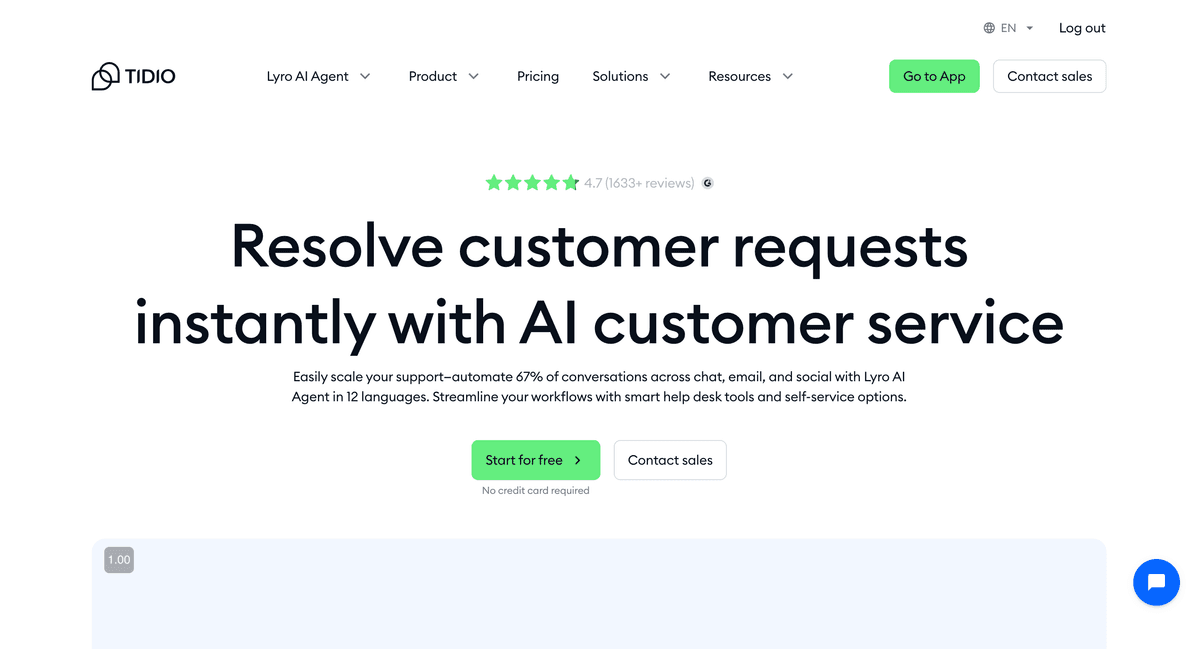
Tidio is an all‑in‑one customer service solution combining live chat, a no‑code AI chatbot (Lyro AI Agent), automated Flows, and a unified inbox for web, email, and social messaging. Setup takes minutes, with Shopify, Messenger, WhatsApp, and email integrations out of the box.
Key Features:
Live Chat with canned responses, live typing previews, pre‑chat surveys, and operator routing.
Lyro AI Agent that automates ~67% of queries, escalates to humans, and supports email thread handling.
Automated Flows: drag‑and‑drop workflows with 40+ templates, triggers (scroll, time, clicks), and lead capture.
Multichannel Inbox: handle web chat, email, Messenger, Instagram, and WhatsApp conversations in one dashboard.
E‑commerce Integrations: Shopify order management (cart previews, order history, discounts) and Zapier connectors.
Analytics & Reporting: real‑time dashboards for conversation metrics, operator performance, Customer Satisfaction Score (CSAT), and Flow performance.
Customization & Branding: widget appearance, brand colors, custom domain, and optional branding removal.
Ticketing & Help Desk: convert chats and emails into tickets, automated workflows, tagging, and priority routing.
Pricing (USD, monthly; annual billing):
Free – $0: up to 50 billable conversations and 100 Flow visitors per month.
Starter – $24.17/mo (billed annually; $29/mo monthly): 100 billable conversations, basic analytics, live visitors list, operating hours, AI Copilot (50 Lyro AI convs), 100 Flow visitors.
Growth – $49.17/mo (billed annually; $59/mo monthly): up to 2,000 billable conversations, advanced analytics, Tidio power features, permissions, optional branding removal (add-on), AI Copilot (50 Lyro AI convs), 100 Flow visitors.
Plus – $749/mo: custom billable conversations, dedicated success manager, custom branding, multisite support, departments, multilanguage, OpenAPI access, premium support, AI Copilot (up to 5,000 Lyro AI convs), configurable Flow visitor limits.
Premium – $2,999/mo: all Plus features plus Lyro as managed service, guaranteed 50% AI resolution rate, priority service, super-admin role, analysis & monitoring.
Tidio Pros and Cons
Pros
- Free forever: up to 50 conversations/month and 100 Flow visitors for unlimited sites.
- Unified platform: combines chat, AI, flows, and ticketing.There is no need for separate tools.
- Strong e‑commerce support: deep Shopify integration and real‑time order actions.
- Intuitive UI: low‑code/no‑code configuration with rich templates and extensions.
Cons
- Free plan limits: capped at 50 conversations and 100 Flow visitors/month.
- Steep paid tiers: Growth ($59) to Plus ($749) to Premium ($2,999) can be cost‑prohibitive for SMBs.
- Conversation‑based billing: may be less granular than per‑message or usage‑based pricing.
Tidio vs Chatbase
Feature
Tidio
Chatbase
Tidio
Chatbase
Pricing Model
Pricing Model
Primary Use Case
Primary Use Case
AI Approach
AI Approach
10. Fin
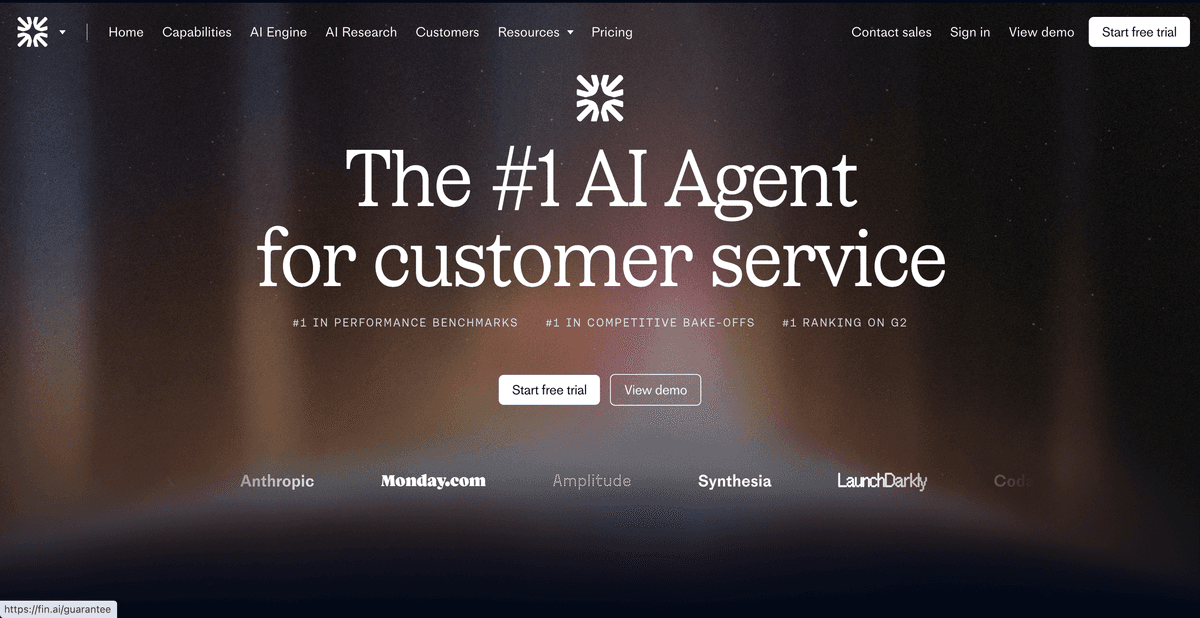
Fin is Intercom’s flagship AI Agent for customer service, touted as the top performer on G2 benchmarks. It integrates with any helpdesk via a lightweight install or through the Intercom Suite to handle conversations across chat, email, phone, SMS, and social channels.
Key Features:
Outcome-based billing: only pay when Fin resolves a conversation.
Multi-channel deployment: chat, email, voice, SMS, WhatsApp, social, API.
No-code customization: configure responses, handover rules, and routing without developers.
Analytics & Reporting: resolution rate dashboards, conversation monitoring, topic insights.
Enterprise security: ISO-certified, GDPR/CCPA compliant, configurable alerts.
Pricing (USD, monthly):
Resolution Fee – $0.99 per resolved conversation, 50 resolution minimum ($49.50/mo).
Intercom Subscription – seats start at $39/seat mo (Essential), $99/seat mo (Advanced), $139/seat mo (Expert) billed annually.
Fin Pros and Cons
Pros
- Proven 65%+ resolution rate in head-to-head tests
- Predictable outcome-based spend with controllable limits.
- Seamless integration into existing helpdesk workflows and automation rules.
Cons
- 50 resolution/month minimum (min spend $49.50).
- Requires an active Intercom subscription (seat-based pricing).
- Per-resolution cost can escalate for high-volume support.
Fin vs Chatbase
Feature
Fin
Chatbase
Fin
Chatbase
Pricing Model
Pricing Model
Deployment
Deployment
Primary Use Case
Primary Use Case
Open-Source Chatbot Platforms (Self-Hosted Alternatives)
Open-source, self-hosted chatbot platforms give you complete control over your data, infrastructure, and customization.
You install the software on your own servers (or cloud instances), modify the code as needed, and avoid vendor lock-in or per-message fees. While they require developer resources to set up and maintain, they’re ideal for businesses that need full flexibility, on-premises deployment, or advanced integrations that go beyond typical SaaS constraints.
11. Botpress
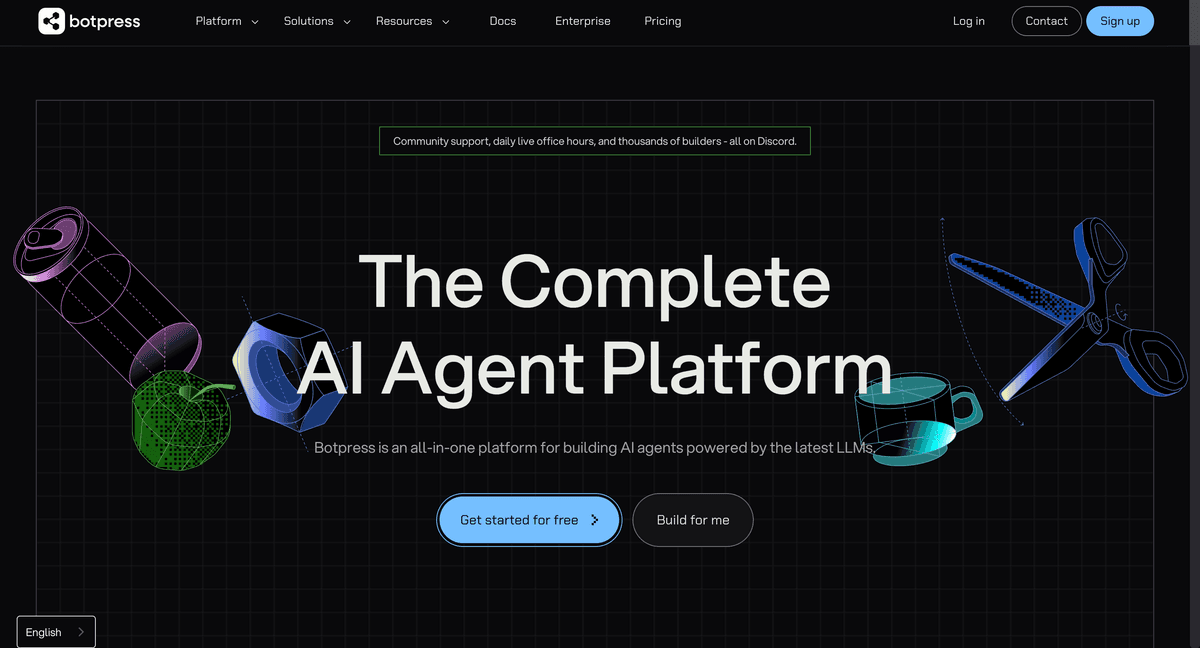
Botpress is a free, open-source AI agent platform you can self-host under the MIT License. It combines a visual flow builder with LLM-powered “Autonomous Engine” features to run AI agents in production.
Key Features:
Agent Studio: Drag-and-drop builder for designing conversational flows and previewing in a built-in emulator.
Autonomous Engine: Orchestrates the latest LLMs (OpenAI, Anthropic, Groq, HuggingFace) to guide conversations and execute tasks.
Knowledge Bases & Tables: Ingest documents, websites, and manage structured data for semantic search and retrieval.
Channel Connectors: Deploy to WhatsApp, Instagram, Facebook Messenger, Slack, and more.
Integration Hub: Native integrations with HubSpot, Notion, Jira, Calendly; plus a robust API for custom connectors.
Pricing (Self-Hosted):
Free under the MIT License for unlimited usage.
Cloud/Enterprise plans (optional) start at $0/mo (Pay-as-you-go) and scale to $495+/mo for Team, with custom pricing for Enterprise deployments.
Botpress Pros and Cons
Pros
- Zero licensing costs: Core platform is free under MIT.
- Full code access: Modify or extend any component - ideal for bespoke workflows.
- Rich ecosystem: 600 k+ builders, active Discord community, and extensive documentation.
- Modular architecture: Pick only the components you need (NLU, analytics, channels, etc.).
Cons
- Developer-centric: Requires hosting, setup, and maintenance by your team.
- Resource overhead: You must manage infrastructure scaling, security patches, and backups.
- Steep learning curve: Advanced features (vector DB, tables, custom models) need configuration.
Botpress vs Chatbase
Feature
Botpress
Chatbase
Botpress
Chatbase
Pricing
Pricing
Deployment
Deployment
Customization
Customization
Primary Use Case
Primary Use Case
12. Microsoft Bot Framework
Microsoft Bot Framework is an open-source SDK and toolkit for building, testing, deploying, and managing conversational AI bots. You can self-host it under the MIT license or run it as a managed service on Azure via Azure AI Bot Service.
Key Features:
Multi-language SDKs: Official libraries for C#, JavaScript/TypeScript, Python, and Java.
Bot Framework Composer: Visual authoring canvas to design dialogs, language understanding, and user flows.
Bot Framework Emulator: Local testing tool with debugging and inspection of “activity” objects.
Channel Connectors: Out-of-the-box support for 30+ channels including Teams, Slack, Facebook Messenger, Telegram, and Direct Line Web Chat.
Cognitive Service Integrations: Seamless hooks into LUIS (language understanding), QnA Maker, Speech, and other Azure Cognitive Services.
Direct Line & Web Chat Controls: Embeddable chat UI components for web or custom clients.
Pricing:
Self-Hosted: Free under the MIT license; no direct platform fees.
Azure AI Bot Service (Managed):
Standard Channels (Teams, Messenger, Slack, etc.): Unlimited messages, free.
Premium Channels (Direct Line, Web Chat): $0.50 per 1,000 messages after the first 10,000 free messages each month.
Hosting: Billed at standard Azure App Service rates (e.g., a B1/S1 web app at approximately $70 - 80/month).
Microsoft Bot Framework Pros and Cons
Pros
- Free & Open-Source: Full source code under MIT license, no licensing fees.
- Extensible & Customizable: Code-level access lets you tailor every aspect of bot logic, UI, and integrations.
- Enterprise-Grade: Integrates with Azure security (SSO, encryption, compliance), monitoring (Application Insights), and scaling.
- Broad Ecosystem: Large community, extensive documentation, and rich ecosystem of tools and samples.
Cons
- Developer-Heavy: Requires programming expertise, DevOps for hosting, and ongoing maintenance.
- Azure Costs: While the SDK is free, hosting on Azure incurs App Service and Cognitive Service charges.
- Complexity: Steep learning curve to configure LUIS, QnA Maker, and advanced channel routing.
Microsoft Bot Framework vs. Chatbase
Feature
Microsoft Bot Framework
Chatbase
Microsoft Bot Framework
Chatbase
Deployment
Deployment
Primary Use Case
Primary Use Case
Pricing
Pricing
Customization
Customization
13. LLaMA
LLaMA (Large Language Model Meta AI) is Meta’s family of high-performance foundation models, released under a source-available license. Debuting in February 2023, it’s evolved through LLaMA 1, LLaMA 2, LLaMA 3 (8 B–405 B parameters), and most recently LLaMA 4.
Key Features:
Model Sizes & Architecture: From 1 B up to 2 T parameters (Behemoth); LLaMA 4 uses a mixture-of-experts design for efficiency and scale.
Multimodal & Long Context: Text + image input with up to 10 M-token context windows for large-scale documents and code.
Instruction-Tuned Variants: LLaMA 3.x and Code Llama (fine-tuned for chat and coding tasks) deliver strong conversational and developer workflows.
Open Weights & Code: Pretrained weights and inference code are available on GitHub under the Meta Llama license, enabling commercial usage, self-hosting, and custom fine-tuning.
Framework Compatibility: Runs on PyTorch, TensorFlow, and optimized runtimes (e.g., llama.cpp) with quantization and GPU/CPU support.
Pricing:
Software License: Free under Meta’s source-available license; no platform fees.
Infrastructure Costs: Self-hosting on cloud GPUs (e.g., AWS p4d: ~$3/hr) or on-prem hardware - costs vary by scale and utilization.
LLAMA Pros and Cons
Pros
- State-of-the-Art Performance: Competes with GPT-4 benchmarks at lower parameter counts.
- Total Control: No per-message fees, full data privacy, and bespoke fine-tuning.
- Scalable Flexibility: Choose lightweight models for on-premise or large mixtures-of-experts for high-throughput cloud inference.
- Vibrant Ecosystem: Broad community support via Hugging Face, open-source tooling, and third-party integrations.
Cons
- Infrastructure Demands: Requires significant GPU/CPU resources and DevOps for hosting, scaling, and maintaining performance.
- License Nuances: LLaMA 3’s Community License places research/commercial restrictions; weight access may require approval.
- No Built-In UI or Ingestion Pipelines: You must build chat interfaces, vector databases, and document ingestion yourself.
- Technical Complexity: Configuring experts, long-context optimization, and operationalizing production deployments demands specialized expertise.
LLAMA vs Chatbase
Feature
LLAMA
Chatbase
LLAMA
Chatbase
Pricing
Pricing
Primary Use Case
Primary Use Case
Deployment
Deployment
Customization
Customization
14. OpenDialog
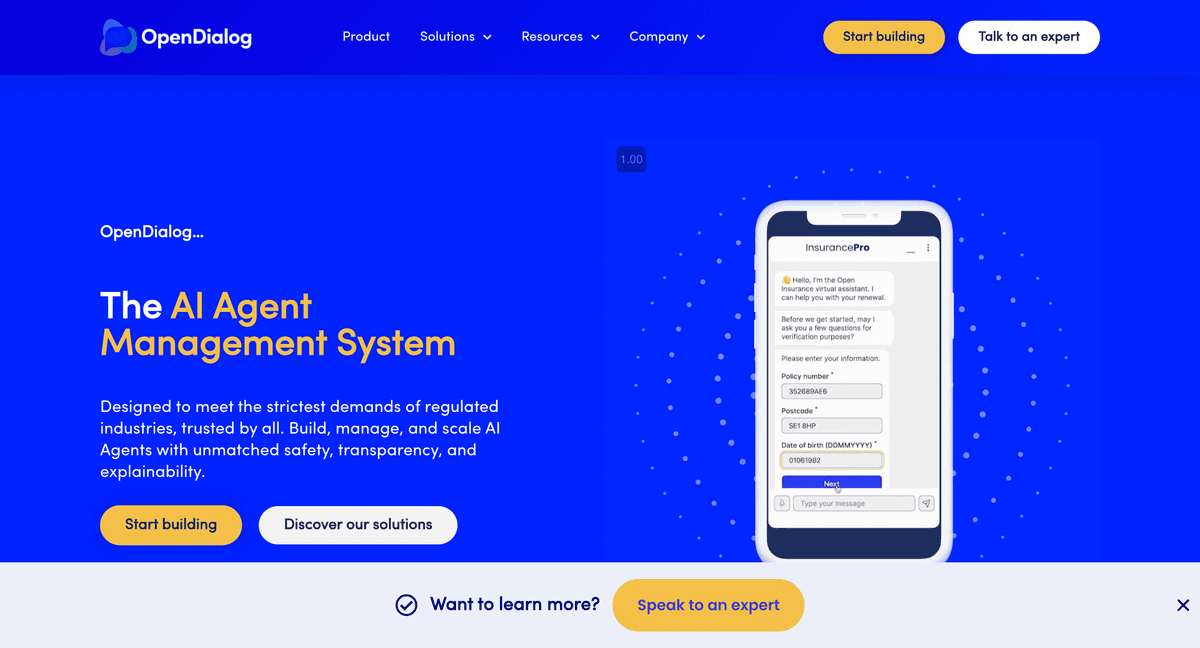
OpenDialog is an open-source (MIT license) AI Agent Management System you can self-host or run as a managed SaaS. It provides a no-code interface for designing, maintaining, and scaling enterprise-grade conversational AI agents quickly and safely.
Key Features:
No-Code Conversation Designer: Visual “Workspace” with drag-and-drop flows and built-in emulator for rapid prototyping and testing.
Multilayered LLM Guardrails & Audit Trails: Configure safety rules at each interaction and log every decision in an auditable database.
RAG & Knowledge Management: Ingest documents, websites, and other data sources; vectorize content for retrieval-augmented generation to deliver accurate, context-aware responses.
Extensible Integrations: Native connectors and a robust API for webhooks, custom actions, and channels like Webchat, Slack, Microsoft Teams, and voice interfaces.
Analytics & Monitoring: Real-time dashboards for conversation volume, intent classification accuracy, error reports, and version history with rollback capabilities.
Multilingual & Translation Support: Define language services, translate conversational content at scale, and test multilingual bots within the platform (Translate in Alpha).
Pricing (USD, monthly):
Free – $0: Full SaaS experimentation tier; unlimited self-hosting under MIT license.
Enterprise – Custom: MAU-based quotes with enterprise SLAs, compliance certifications, and dedicated support—contact sales for details.
OpenDialog Pros and Cons
Pros
- Cost-Effective: Core platform is free under the MIT license with no per-message fees.
- Full Control & Compliance: Self-hosting grants complete data residency, security, and auditability - ideal for regulated industries.
- Deep Customization: Access to all source code allows bespoke extensions, custom UIs, and integration of complex enterprise systems.
- Scalable: From prototype to high-volume deployments, you choose infrastructure—on-prem or cloud.
Cons
- Technical Overhead: Requires DevOps for hosting, scaling, security patching, and backups.
- Learning Curve: Advanced features (guardrails, RAG, custom actions) necessitate in-depth configuration.
- Enterprise Pricing: SaaS enterprise plans are custom MAU-based; on-premises infrastructure costs vary by deployment.
OpenDialog vs Chatbase
Feature
OpenDialog
Chatbase
OpenDialog
Chatbase
Pricing
Pricing
Primary Use Case
Primary Use Case
Deployment
Deployment
Customization
Customization
15. DeepPavlov
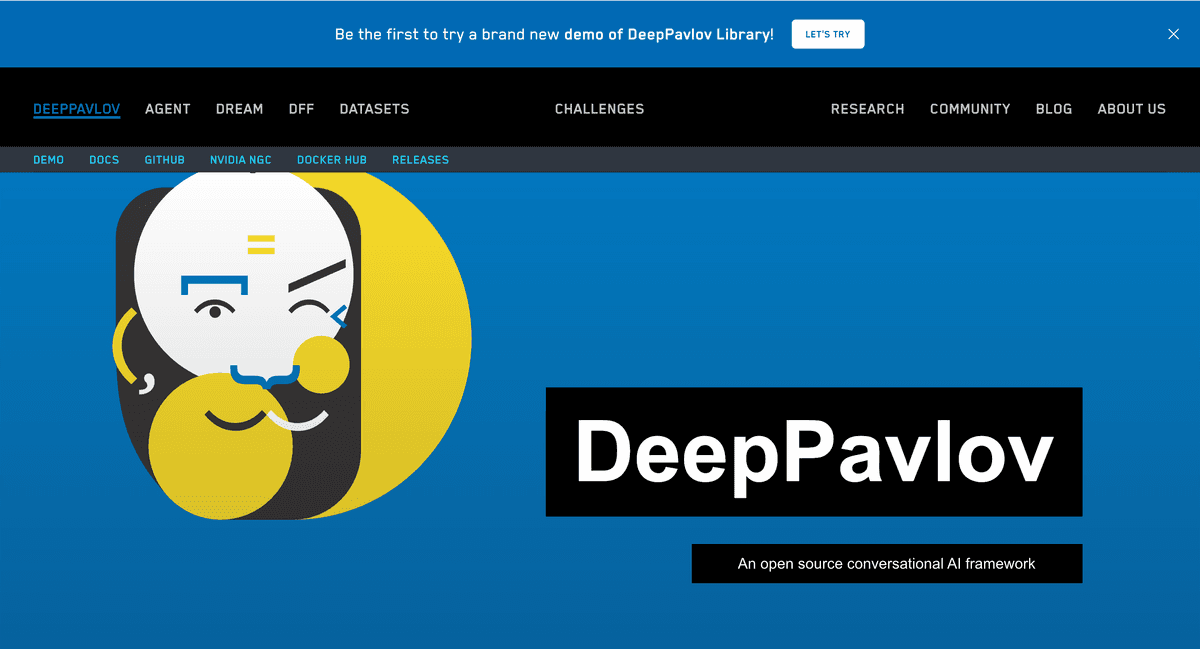
DeepPavlov is an open-source conversational AI framework under the Apache 2.0 license. It equips developers and NLP researchers with modular components and pretrained pipelines for building production-ready chatbots, virtual assistants, and complex multi-skill agents.
Key Features:
Modular NLP Pipelines: Out-of-the-box models for intent classification, named entity recognition, slot filling, and question answering (BERT-based, R-Net, Bi-LSTM+CRF).
DeepPavlov Agent & Dream: Orchestrates multiple “skills” or sub-agents to handle multi-turn, multi-skill dialogues via API services.
Deployment Flexibility: Install via Python package, Docker image, or run on Kubernetes; embed via REST APIs or chat widgets.
Channel Connectors: Native support for Slack, Telegram, Facebook Messenger, Twilio SMS, and custom channels.
Configuration-Driven: JSON/YAML-based configuration lets you define complex conversational flows without deep coding.
Pricing (Self-Hosted):
Free under Apache 2.0 - no platform fees.
Optional Enterprise Support: Commercial support and managed hosting available via third-party providers (pricing varies by vendor).
DeepPavlov Pros and Cons
Pros
- Zero Licensing Cost: Completely free under Apache 2.0, with no per-message fees.
- Extensive Pretrained Models: Leverage SOTA transformers and deep learning architectures for diverse NLP tasks.
- Active Community & Docs: Detailed tutorials, Colab notebooks, forums, and 600 k+ downloads on GitHub.
- Full Code Access: Modify or extend any component to suit bespoke enterprise requirements.
Cons
- Developer-Centric: Requires in-house engineering to set up, configure, and maintain.
- No GUI by Default: Lacks a native visual flow builder - UI must be custom-built or use Dream.
- Operational Overhead: You manage all infrastructure, scaling, security patches, and backups.
DeepPavlov vs Chatbase
Feature
DeepPavlov
Chatbase
DeepPavlov
Chatbase
Pricing
Pricing
Primary Use Case
Primary Use Case
Deployment
Deployment
Customization
Customization
16. Claudia Bot Builder
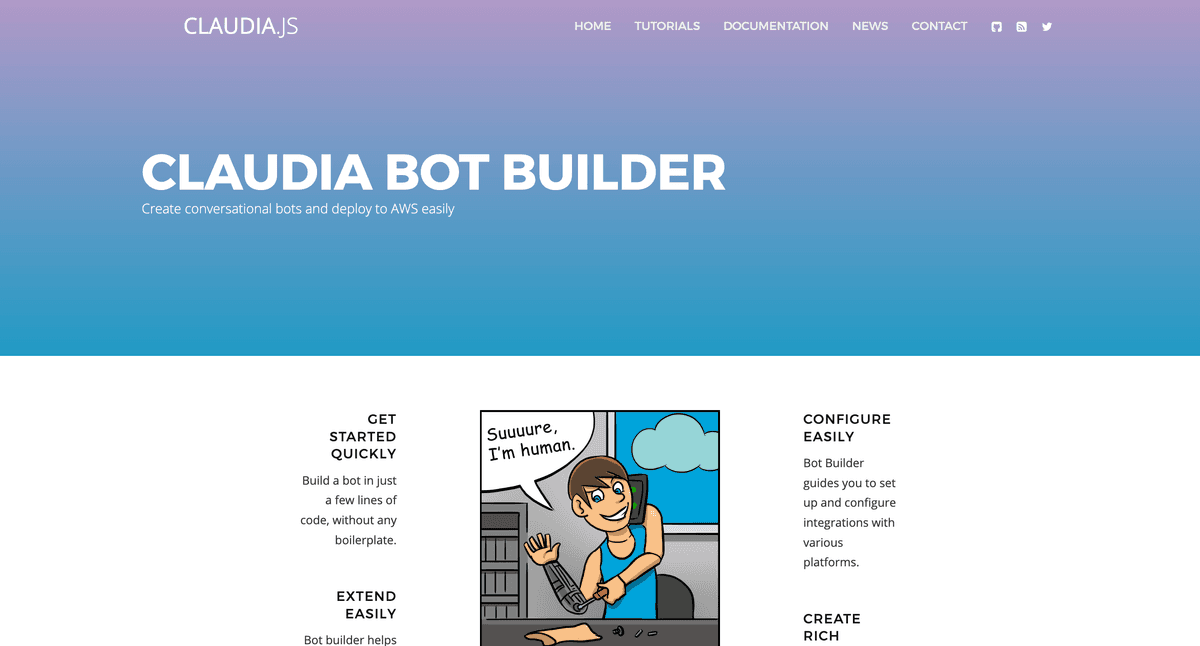
Claudia Bot Builder is a lightweight, MIT-licensed extension for Claudia.js that lets you create and deploy chatbots across multiple messaging platforms in minutes. It removes boilerplate by automatically configuring AWS Lambda and API Gateway webhooks for channels like Facebook Messenger, Telegram, Slack, Skype, Twilio, Kik, and GroupMe.
Key Features:
Zero Boilerplate: Define your bot’s business logic in a single callback; Claudia handles webhook setup, request parsing, and response formatting.
Multi-Platform Support: Out-of-the-box connectors for Messenger, Telegram, Slack slash-commands, Skype, Viber, Twilio SMS, Kik, GroupMe, and more.
Rich Message Helpers: Built-in helper functions for buttons, quick replies, carousels, receipts, and media attachments.
Automatic Versioning: Deploy “test” and “production” versions side-by-side with simple CLI flags.
Extensible: Integrate any NPM package - connect to databases, call external APIs, or include custom logic.
Pricing (Self-Hosted):
Software: Free under the MIT license.
Infrastructure: Billed per AWS Lambda invocation and API Gateway requests (e.g., Lambda at $0.20/million requests; API Gateway at $3.50/million requests).
Claudia Pros and Cons
Pros
- Free & Open-Source: No licensing fees; code under MIT license.
- Serverless-Ready: Optimized for AWS Lambda/API Gateway, so you pay only for usage.
- Ultra-Lightweight: Minimal dependencies and fast cold-start times compared to monolithic frameworks.
- Developer-Friendly: Write and test in pure JavaScript or TypeScript; full control over code and deployment.
Cons
- Developer-Only: No visual flow builder or GUI - requires coding and AWS familiarity.
- Infrastructure Management: You must configure AWS IAM roles, Lambda permissions, and manage logs/monitoring.
- No Built-in Analytics: Lacks dashboards; you’ll need to wire up your own metrics (e.g., CloudWatch, Datadog).
Claudia vs Chatbase
Feature
Claudia
Chatbase
Claudia
Chatbase
Deployment
Deployment
Pricing
Pricing
Primary Use Case
Primary Use Case
Analytics & Monitoring
Analytics & Monitoring
Customization
Customization
17. BotMan
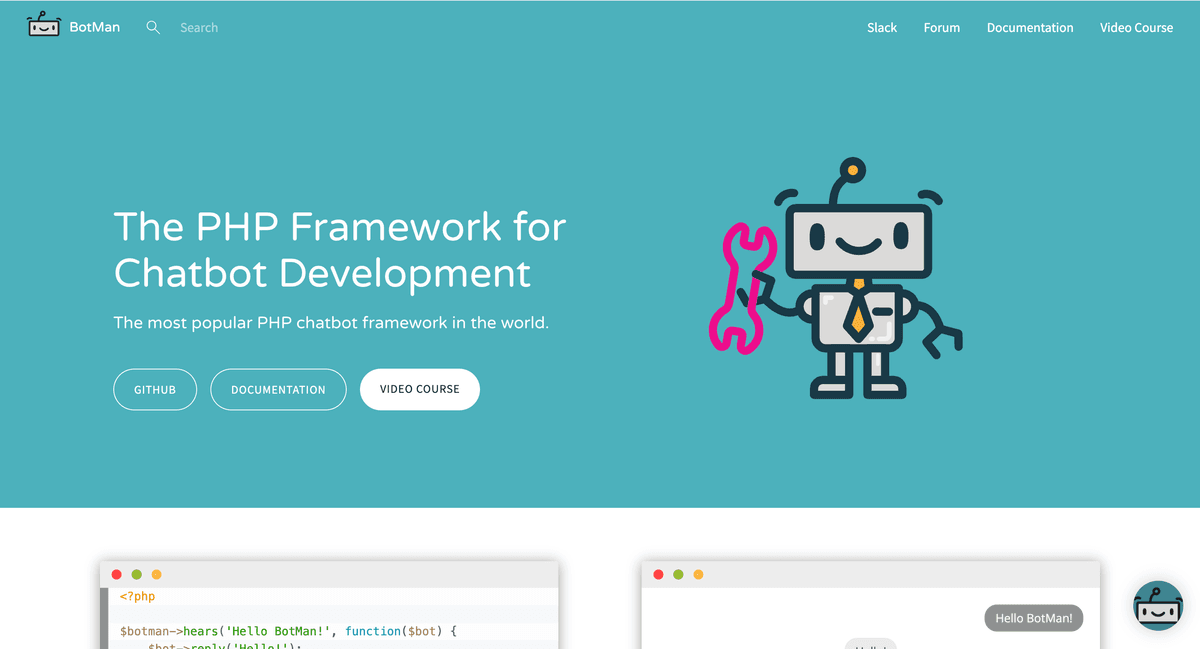
BotMan is a framework-agnostic PHP library for building chatbots that run on your own servers. Write your conversational logic once and connect it to multiple messaging platforms - web widget, Slack, Telegram, Facebook Messenger, Alexa, and more - without locking into a single vendor.
Key Features:
One Codebase, Multiple Drivers: Install drivers via Composer (botman/driver-slack, botman/driver-facebook, etc.) to support new channels on the fly.
BotMan Studio: Laravel-based boilerplate project that includes a ready-to-use web “tinker” UI for local development and testing.
Conversation Builder: Chain questions, fallback logic, and rich media replies (buttons, images, quick replies) with expressive PHP syntax.
Middleware & Customization: Add pre- and post-processing hooks, custom message parsers, and integrate any NPM or PHP package.
Driver Ecosystem: First-class support for popular platforms (Slack, Messenger, Telegram, Twilio, Alexa) and a plugin system for bespoke channels.
Open Documentation & Community: Detailed docs, video tutorials, and an active Discord/Slack community to help you troubleshoot and extend functionality.
Pricing:
Free: BotMan library and Studio are MIT-licensed with no platform fees.
Support & Services (Optional): Commercial support, training, and bespoke development available from Beyond Code (pricing varies by engagement).
Botman Pros and Cons
Pros
- Free & Open-Source: Core library and Studio are MIT-licensed - no fees for usage or redistribution.
- PHP Ecosystem: Ideal for teams already using Laravel or PHP, with seamless integration into existing applications.
- Full Code Control: Modify every aspect of the bot logic, drivers, and deployment pipeline.
- Lightweight & Serverless Ready: Works well in containerized or serverless (AWS Lambda via Bref) environments.
Cons
- Developer-Only: No visual flow editor - requires PHP knowledge and development resources.
- Infrastructure Overhead: You must handle hosting, scaling, monitoring, and backups yourself.
- No Built-In Analytics: Lacks native dashboards; you’ll need to plug in third-party analytics tools.
- Framework Bound: PHP-centric; not suitable if your stack is Python, Node.js, or .NET.
Botman vs Chatbase
Feature
Botman
Chatbase
Botman
Chatbase
Pricing
Pricing
Primary Use Case
Primary Use Case
Deployment
Deployment
Customization
Customization
18. Tock
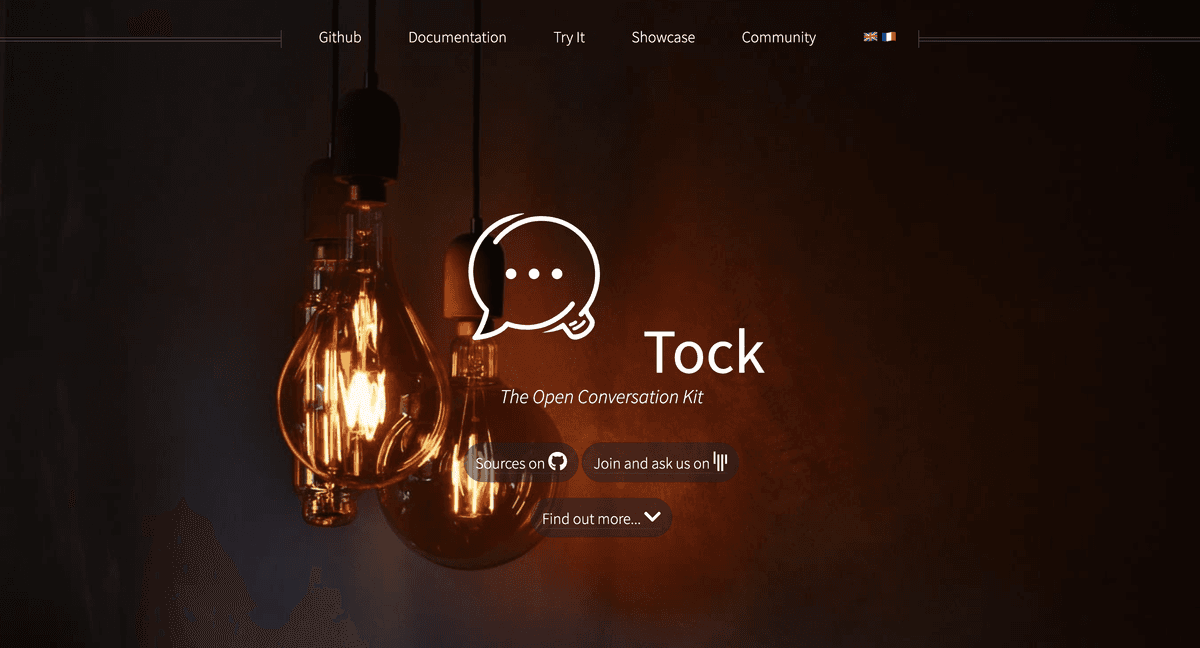
Tock (The Open Conversation Kit) is an open-source conversational AI platform released under the Apache 2.0 license. You can self-host it or deploy via Docker/Kubernetes, giving you full ownership of your models, data, and infrastructure; no reliance on third-party APIs unless you choose to integrate them.
Key Features:
Story & Flow Designer: Visual “Tock Studio” interface to build conversation flows, test in a built-in emulator, and manage versions.
Modular NLP Stack: Plug in your choice of NLU engines (OpenNLP, Stanford, Rasa, Hugging Face) for intent classification, entity extraction, slot filling, and semantic search.
Conversational DSL & APIs: Define dialogues in Kotlin, Node.js, Python, or via REST; use a domain-specific language for fine-grained control.
Multichannel Connectors: Out-of-the-box integration with web chat, Slack, Telegram, WhatsApp, Facebook Messenger, Google Assistant, Alexa, Twitter, and more.
Knowledge & Data Management: Ingest documents, websites, and structured data into Tock’s knowledge base for retrieval-augmented responses.
Extensible & Pluggable: Build custom actions, analytics dashboards, and channel connectors; leverage Docker images or Helm charts for scalable deployments.
Pricing (Self-Hosted):
Core Platform: Free under Apache 2.0 - no fees for software.
Commercial Support (Optional): Third-party vendors offer managed hosting, SLAs, and professional services (pricing varies).
Tock Pros and Cons
Pros
- Free & Open-Source: No licensing or usage fees—remove vendor lock-in.
- Full Customization: Access to all source code lets your team tailor every component, from NLU models to UI.
- Active Community & Enterprise Adoption: Backed by contributions from major organizations (e.g., SNCF) and an engaged Discord/GitHub community.
- Modular Architecture: Only deploy the services you need - NLU, dialogue engine, analytics, channels - minimizing overhead.
Cons
- Developer-Centric: Requires in-house engineering for setup, hosting, scaling, and maintenance.
- Operational Overhead: You’re responsible for infrastructure (Kubernetes, Docker), security patches, backups, and monitoring.
- Learning Curve: Mastering the Domain Specific language (DSL), Studio UI, and integration workflows can take time compared to turnkey SaaS.
Tock vs Chatbase
Feature
OpenDialog
Chatbase
OpenDialog
Chatbase
Pricing
Pricing
Primary Use Case
Primary Use Case
Deployment
Deployment
Customization
Customization
19. Bottender
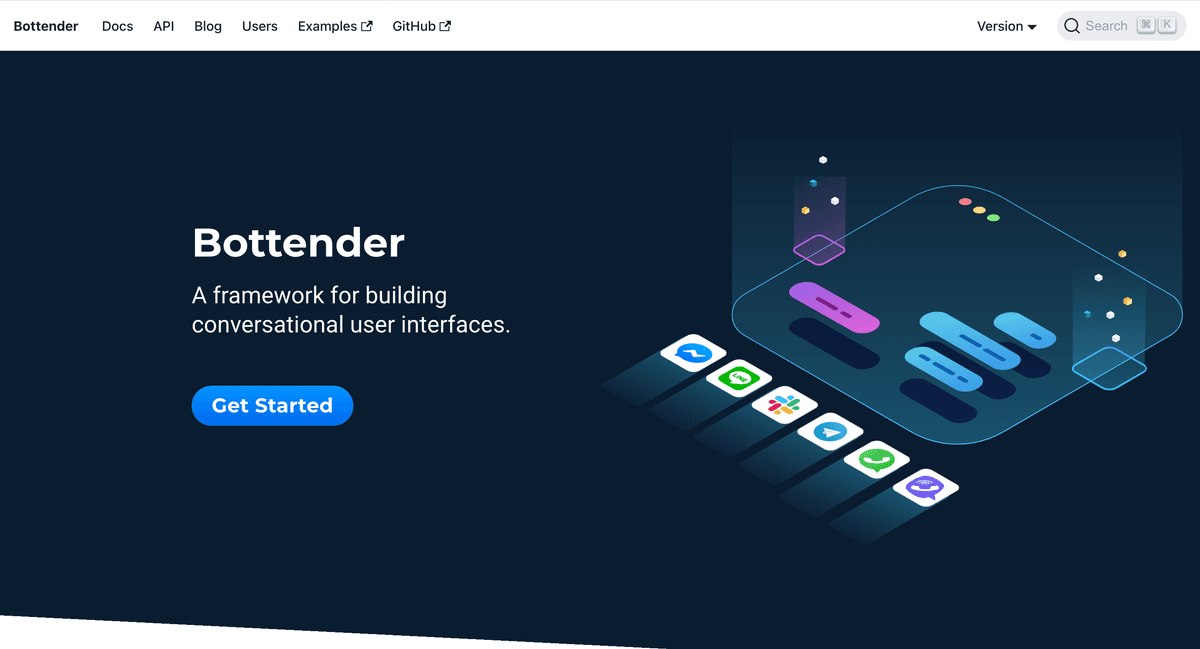
Bottender is a lightweight, MIT-licensed JavaScript framework for building conversational UIs across multiple messaging platforms. It provides a declarative API that abstracts away webhook setup, server configuration, and protocol details - letting you focus on crafting bot behavior without compromise.
Key Features:
Declarative Routing: Define “actions” for each event and conversation state; Bottender handles the rest, making your code predictable and easy to debug.
Native User Experience: Supports progressive enhancement or graceful degradation to ensure consistent UX across channels.
Easy Setup: Minimal configuration automatically establishes servers, webhooks, and signature verification for each channel.
Production-Ready: Optimized for real-world workloads with automatic request batching and zero-downtime deployments - thousands of bots run on Bottender today.
Multi-Channel Support: Built on top of any Messaging-API–compliant channel (e.g., Facebook Messenger, Slack, Telegram, LINE) via a simple driver architecture.
Pricing:
Software: Free under the MIT license - no platform fees.
Infrastructure: Pay only for your hosting (e.g., container or cloud VM costs); no usage-based charges.
Bottender Pros and Cons
Pros
- Free & Open-Source: No licensing fees; full code access under the MIT license.
- Full Control: Code-first framework gives you the flexibility to extend or replace any component.
- High Performance: Automatic batching and lightweight architecture make it ideal for scale.
- Vibrant Community: Active Discord, GitHub, and Stack Overflow channels provide support and shared examples.
Cons
- Developer-Centric: No visual flow builder; requires JavaScript/TypeScript expertise.
- Infrastructure Overhead: You must provision and maintain your own hosting, scaling, and monitoring.
- No Built-In Analytics or GUI: You’ll need to integrate third-party tools or build custom dashboards for metrics.
Bottender vs. Chatbase
Feature
Bottender
Chatbase
Bottender
Chatbase
Pricing
Pricing
Primary Use Case
Primary Use Case
Deployment
Deployment
Customization
Customization
Choosing the Right Chatbase Alternative for Your Business
Comparing Key Features of Chatbase Alternatives
Once you know what you’re looking for in a chatbot solution, it’s time to roll up your sleeves and compare features across the alternatives.
Advanced analytics should be high on your checklist. The best platforms don’t just log conversations; they help you uncover trends, understand customer pain points, and measure how effectively your bot resolves issues.
Customization is another biggie. Whether it’s tweaking your bot’s personality, adding custom workflows, or controlling brand styling, the flexibility to make the tool your own can make all the difference in how seamlessly it fits into your customer experience.
Don’t forget about integrations. A good chatbot shouldn’t exist in a silo. Make sure the platform plays nicely with your existing tech stack - CRMs, helpdesks, e-commerce tools, marketing platforms - so you can create smooth workflows without constant manual updates.
Finally, consider the user experience on your end. A user-friendly interface can save your team countless hours in setup and maintenance. Even the most powerful chatbot features lose their shine if they’re buried under a clunky or confusing UI.
How to Evaluate Pricing Models of Chatbase Alternatives
Let’s talk money - because no matter how shiny the features, cost is always part of the conversation.
When evaluating Chatbase alternatives, dig deeper than just the headline price tag. Some tools offer affordable entry-level plans but tack on costs for extra usage, integrations, or premium features. Others might appear pricey upfront but deliver excellent value if they cover all your needs out of the box.
Start by considering initial costs. Are there setup fees, onboarding charges, or minimum contract lengths? Then look at the ongoing costs, like monthly or annual subscriptions, overage fees if you exceed message or conversation limits, or add-ons for premium capabilities.
Also, weigh the total cost of ownership. For open-source platforms, the software might be free, but hosting, development time, and ongoing maintenance can add up. On the flip side, fully managed SaaS solutions handle the heavy lifting but may carry steeper subscription fees.
In the end, the best value often comes down to fit. A slightly higher-priced platform might save you money (and headaches) in the long run if it reduces manual work, integrates seamlessly with your existing systems, and scales alongside your business.
The Importance of Customer Support and Documentation When Choosing a Chatbase Alternative
A chatbot platform might be packed with features - but if you can’t get help when you need it, you’re in for a frustrating ride.
Customer support can make or break your experience. Look for alternatives that offer timely, helpful responses via live chat, email, or even phone. Especially if you’re handling sensitive data or large user volumes, knowing you have backup when things go sideways is priceless.
Equally crucial is documentation. Good platforms invest in clear, detailed resources to help you get the most from their tools. Keep an eye out for:
Guides to walk you through core tasks.
Tutorials that show step-by-step workflows.
FAQs that address common roadblocks.
These resources save time, reduce mistakes, and help your team ramp up quickly - without leaning on support for every little question.
Look for Trial Periods and Demos
Finally, never skip a trial period or demo if it’s available.
No matter how promising a platform looks on paper, hands-on experience is the best way to see if it’s truly a fit. Use the trial period to explore how intuitive the dashboard is, how quickly you can build a bot, and whether the features perform as advertised.
During your trial, evaluate:
How easy it is to set up and integrate with your current systems.
Whether the chatbot’s responses are accurate and helpful.
If the tool feels scalable for your anticipated growth.
Taking the time to test-drive your options can save you a lot of headaches - and ensure you invest in a solution that genuinely supports your business goals.
Bottom Line
Choosing the right Chatbase alternative comes down to your unique needs—there’s no one-size-fits-all answer. If you’re looking for fast deployment, minimal maintenance, and solid support, proprietary platforms like SiteChatify or Drift might be your best bet. Prefer total control and flexibility? Open-source solutions like Botpress or Microsoft Bot Framework give you the power to customize every detail, provided you have the technical resources.
The key is to balance features, costs, and the effort you’re willing to invest. Don’t be afraid to take advantage of free trials, demos, and user reviews - they’re your best allies in finding the perfect fit.
At the end of the day, the right chatbot platform isn’t just about answering questions—it’s about creating seamless experiences that support your customers and help your business grow.
Ready to Build Your AI Chatbot?
Create a smart ai chatbot for your website in just a few minutes. No coding required!
Smart AI Responses
Powered by advanced AI technology
Quick Setup
Get started in under 5 minutes
Free to Start
No credit card required
About the Author
Darius Talemwa
Author

